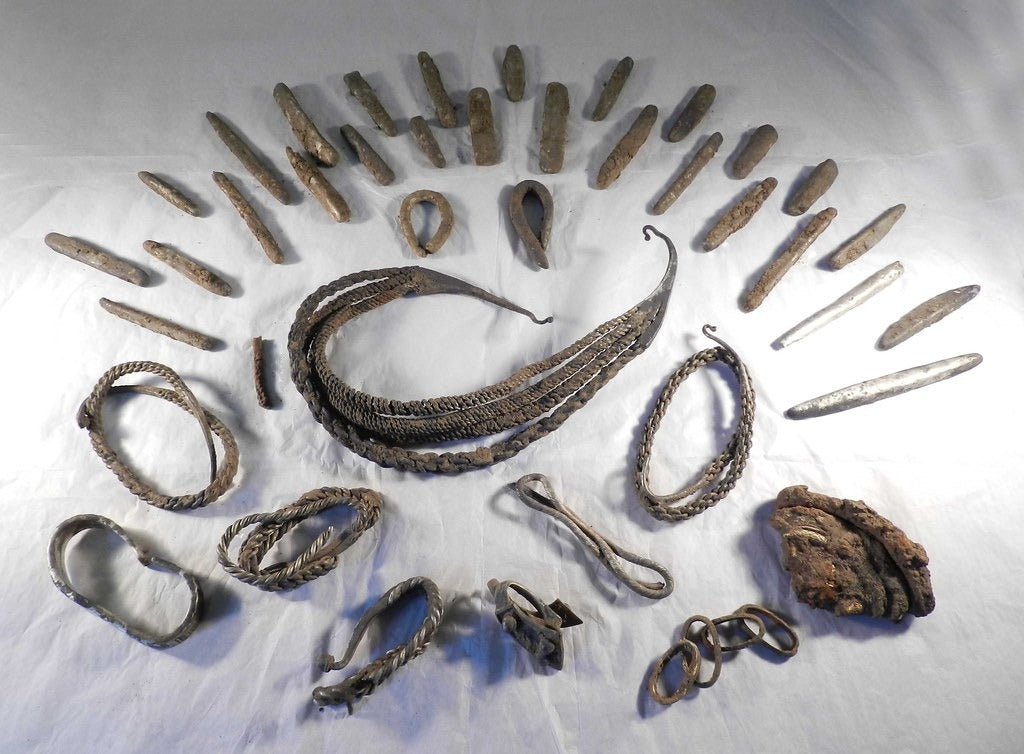
The Skog Tapestry: Medieval Narrative in Thread and Wool
The Skog tapestry, discovered in 1912 at Skog Church in Hälsingland, Sweden, represents one of Scandinavia's most significant medieval textile artifacts. Dating to approximately 1240-1250 CE, this remarkable piece showcases the sophisticated textile traditions of medieval Norse society during a period of significant religious and cultural transformation.
Physical Characteristics and Construction
The tapestry measures 2.3 meters in height and 4.7 meters in width, crafted using a combination of wool weft on a linen warp. The weaving technique employed is typical of medieval Scandinavian textile production, featuring both tabby and twill weaves. The piece demonstrates remarkable preservation considering its age, though some areas show expected deterioration.
Imagery and Symbolism
The tapestry depicts three main scenes arranged horizontally, featuring both Christian and pre-Christian Norse imagery:
Central Procession
The central section portrays three mounted figures, traditionally interpreted as representing kings or saints. Each rider carries distinctive attributes - crosses, weapons, and royal regalia - suggesting a careful blending of religious and secular authority.
Architectural Elements
Flanking the riders are architectural representations resembling both Norse stave churches and medieval European ecclesiastical structures, highlighting the cultural fusion characteristic of 13th-century Scandinavia.
Decorative Borders
The tapestry features intricate border patterns incorporating both geometric designs and stylized flora, demonstrating influences from both Norse and broader European decorative traditions.
Conservation and Research History

Part of the tapestry which depicts three prominent figures. Though assumed to be kings or nobles of some sort, it remains unclear what they represent (Photo: Unknown Author, Public Domain)
Initial Discovery
When discovered during church renovation work in 1912, the tapestry had been repurposed as an altar covering. This secondary use likely contributed to its survival, protecting it from environmental damage.
Modern Conservation
The tapestry underwent major conservation efforts at the Swedish National Heritage Board during the 1920s and again in the 1960s. These interventions stabilized the piece and revealed previously obscured details.
Cultural and Historical Significance
Religious Transition
The tapestry provides crucial evidence for understanding the complex period of religious transition in medieval Scandinavia, where Christian and pre-Christian traditions coexisted and merged.
Artistic Techniques
The piece demonstrates sophisticated weaving techniques and artistic conventions that challenge previous assumptions about medieval Scandinavian textile production capabilities.
Contemporary Relevance and Exhibition

Museum Display
Currently housed in the Swedish History Museum in Stockholm, the Skog tapestry remains one of the institution's most significant medieval artifacts.
Research Impact
Modern technological analysis, including spectroscopic examination and fiber analysis, continues to reveal new information about medieval textile production methods and materials.
Frequently Asked Questions (FAQs)
- When was the Skog tapestry created?
The tapestry dates to approximately 1240-1250 CE, based on stylistic and technical analysis.
- Where was it discovered?
It was found in Skog Church, Hälsingland, Sweden, in 1912.
- What materials were used in its creation?
The tapestry uses wool weft on a linen warp, with natural dyes typical of the period.
- Who are the figures depicted in the tapestry?
The main figures are three mounted individuals, likely representing a combination of religious and secular authorities, though their specific identities remain debated.
- How has the tapestry been preserved?
Through careful conservation efforts by the Swedish National Heritage Board, including major restorations in the 1920s and 1960s.
References
"Skogbonaden - Historiska museet - 96352 HST - 432519" by Ola Myrin is licensed under CC BY 4.0.
Franzén, A. M., & Nockert, M. (1992). Bonaderna från Skog och Överhogdal och andra medeltida väggbeklädnader. Stockholm: Kungliga Vitterhets Historie och Antikvitets Akademien.
Nockert, M. (1995). "The Skog Tapestry: A Medieval Narrative." In Medieval Art in Norway and Sweden. Oslo: Norwegian Academic Press, pp. 123-156.
Andersson, E. (2003). "Textile Production in Medieval Scandinavia." In Medieval Scandinavia: An Encyclopedia. New York: Garland Publishing, pp. 621-624.
Liepe, L. (2009). Studies in Icelandic and Norwegian Medieval Art. Bergen: University of Bergen Press, pp. 245-267.
Vedeler, M. (2014). "The Textile Interior in Medieval Norwegian Churches." In Medieval Clothing and Textiles, Vol. 10. Woodbridge: Boydell Press, pp. 157-171.
Geijer, A. (1994). Medieval Textile Art in Scandinavia. Copenhagen: Rhodos International Publishers, pp. 89-103.
Nilsén, A. (1991). Program och funktion i senmedeltida kalkmåleri. Stockholm: Kungliga Vitterhets Historie och Antikvitets Akademien, pp. 201-215.
Christiansen, E. (2006). The Norsemen in the Viking Age. Oxford: Blackwell Publishing, pp. 258-262.
For the most current and authoritative information about the Skog tapestry, researchers should consult:
- The Swedish History Museum (Historiska museet) archives
- The Swedish National Heritage Board (Riksantikvarieämbetet) documentation
- The Digital Archive of Medieval Norwegian Art History (DIAMANT)
- The Nordic Museum's textile collection database








